BMW X3 2014 F25 Owner's Manual
Manufacturer: BMW, Model Year: 2014, Model line: X3, Model: BMW X3 2014 F25Pages: 251, PDF Size: 5.79 MB
Page 171 of 251
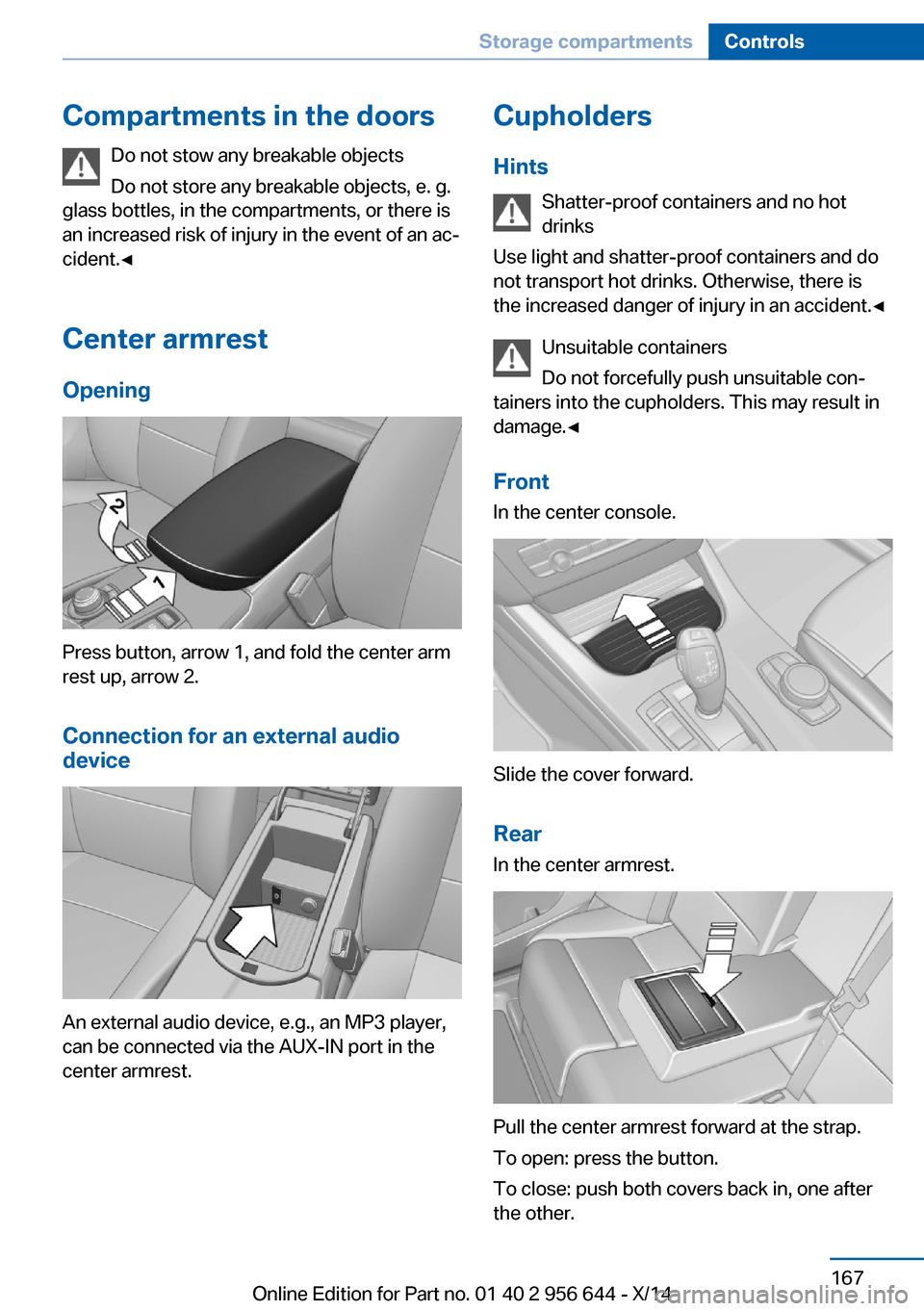
Compartments in the doorsDo not stow any breakable objects
Do not store any breakable objects, e. g.
glass bottles, in the compartments, or there is
an increased risk of injury in the event of an acâ
cident.â
Center armrest
Opening
Press button, arrow 1, and fold the center arm
rest up, arrow 2.
Connection for an external audio
device
An external audio device, e.g., an MP3 player,
can be connected via the AUX-IN port in the
center armrest.
Cupholders
Hints Shatter-proof containers and no hot
drinks
Use light and shatter-proof containers and do
not transport hot drinks. Otherwise, there is the increased danger of injury in an accident.â
Unsuitable containers
Do not forcefully push unsuitable conâ
tainers into the cupholders. This may result in
damage.â
Front
In the center console.
Slide the cover forward.
Rear In the center armrest.
Pull the center armrest forward at the strap.
To open: press the button.
To close: push both covers back in, one after
the other.
Seite 167Storage compartmentsControls167
Online Edition for Part no. 01 40 2 956 644 - X/14
Page 172 of 251
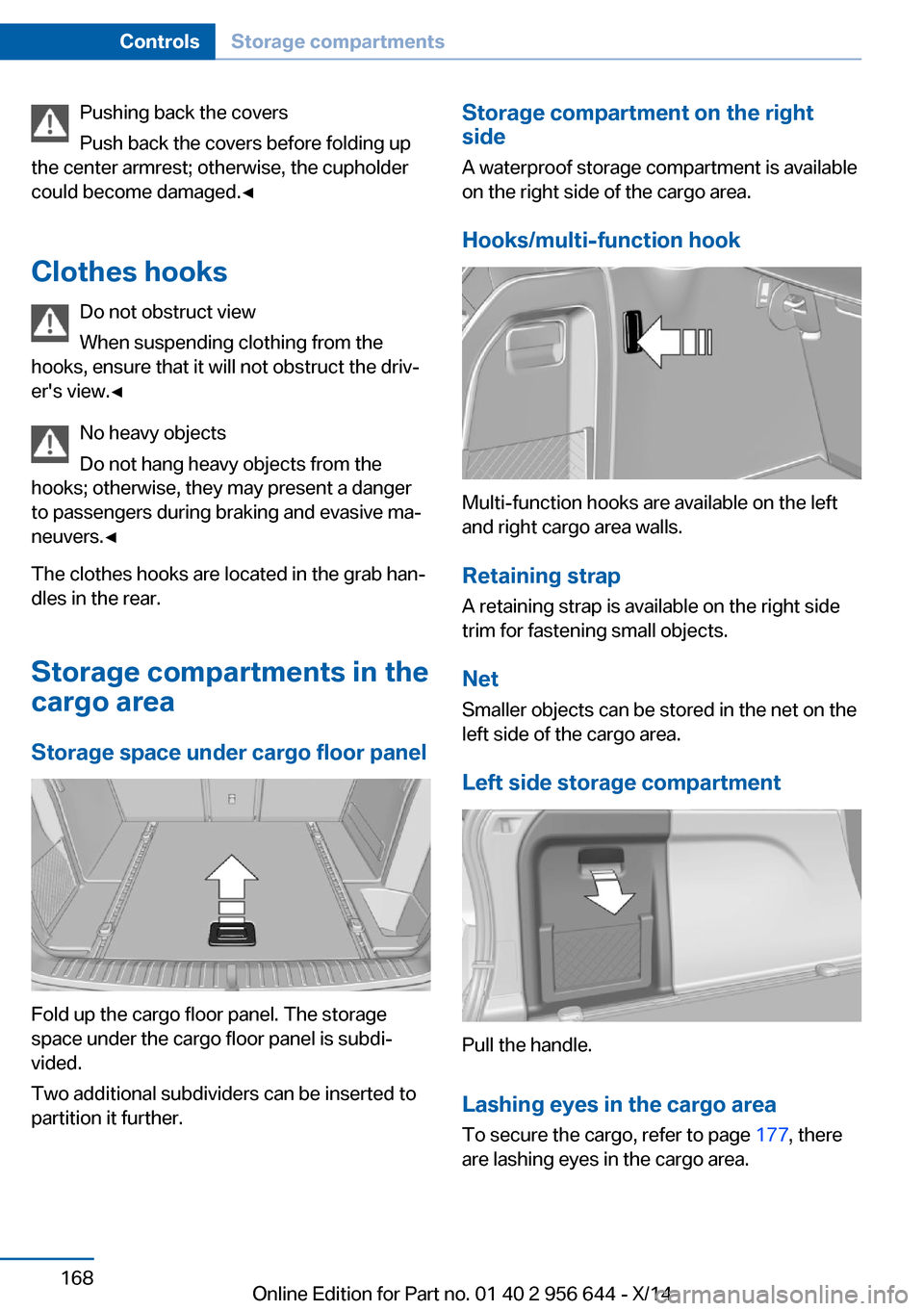
Pushing back the covers
Push back the covers before folding up
the center armrest; otherwise, the cupholder
could become damaged.â
Clothes hooks Do not obstruct view
When suspending clothing from the
hooks, ensure that it will not obstruct the drivâ
er's view.â
No heavy objects
Do not hang heavy objects from the
hooks; otherwise, they may present a danger
to passengers during braking and evasive maâ
neuvers.â
The clothes hooks are located in the grab hanâ
dles in the rear.
Storage compartments in the
cargo area
Storage space under cargo floor panel
Fold up the cargo floor panel. The storage
space under the cargo floor panel is subdiâ
vided.
Two additional subdividers can be inserted to
partition it further.
Storage compartment on the right
side
A waterproof storage compartment is available
on the right side of the cargo area.
Hooks/multi-function hook
Multi-function hooks are available on the left
and right cargo area walls.
Retaining strapA retaining strap is available on the right side
trim for fastening small objects.
Net
Smaller objects can be stored in the net on the
left side of the cargo area.
Left side storage compartment
Pull the handle.
Lashing eyes in the cargo area
To secure the cargo, refer to page 177, there
are lashing eyes in the cargo area.
Seite 168ControlsStorage compartments168
Online Edition for Part no. 01 40 2 956 644 - X/14
Page 173 of 251
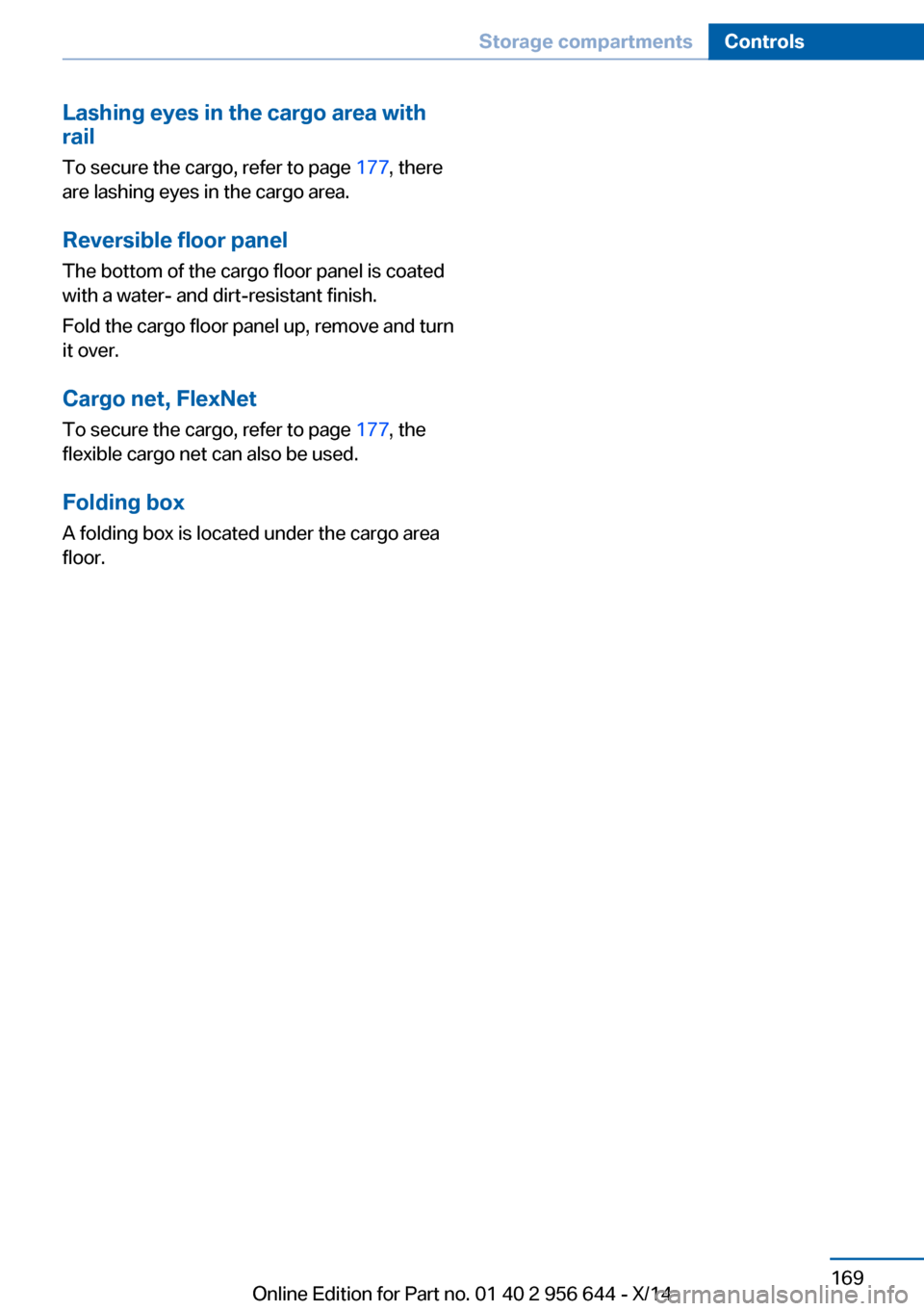
Lashing eyes in the cargo area with
rail
To secure the cargo, refer to page 177, there
are lashing eyes in the cargo area.
Reversible floor panel The bottom of the cargo floor panel is coated
with a water- and dirt-resistant finish.
Fold the cargo floor panel up, remove and turn
it over.
Cargo net, FlexNetTo secure the cargo, refer to page 177, the
flexible cargo net can also be used.
Folding box
A folding box is located under the cargo area
floor.Seite 169Storage compartmentsControls169
Online Edition for Part no. 01 40 2 956 644 - X/14
Page 174 of 251
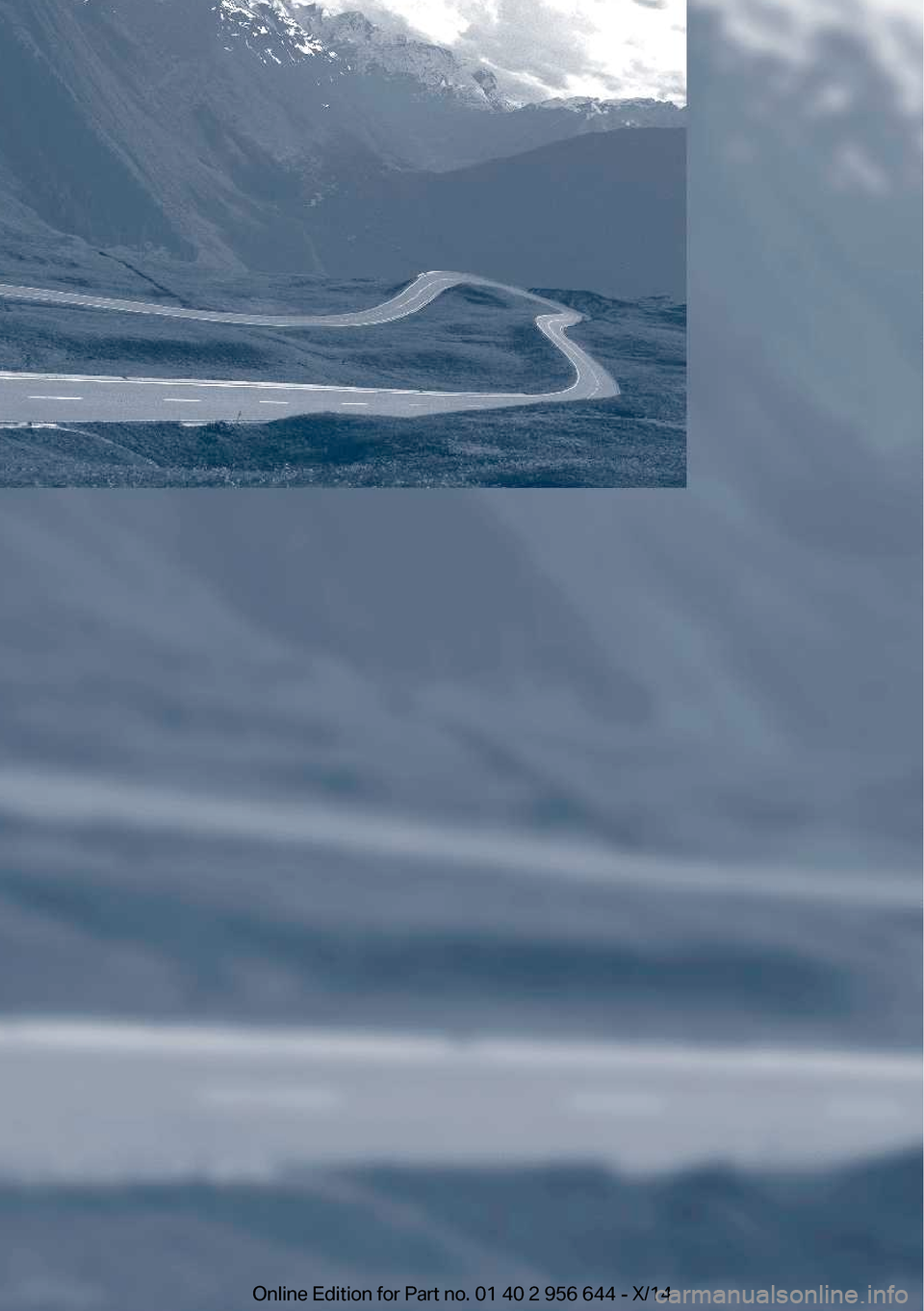
Online Edition for Part no. 01 40 2 956 644 - X/14
Page 175 of 251
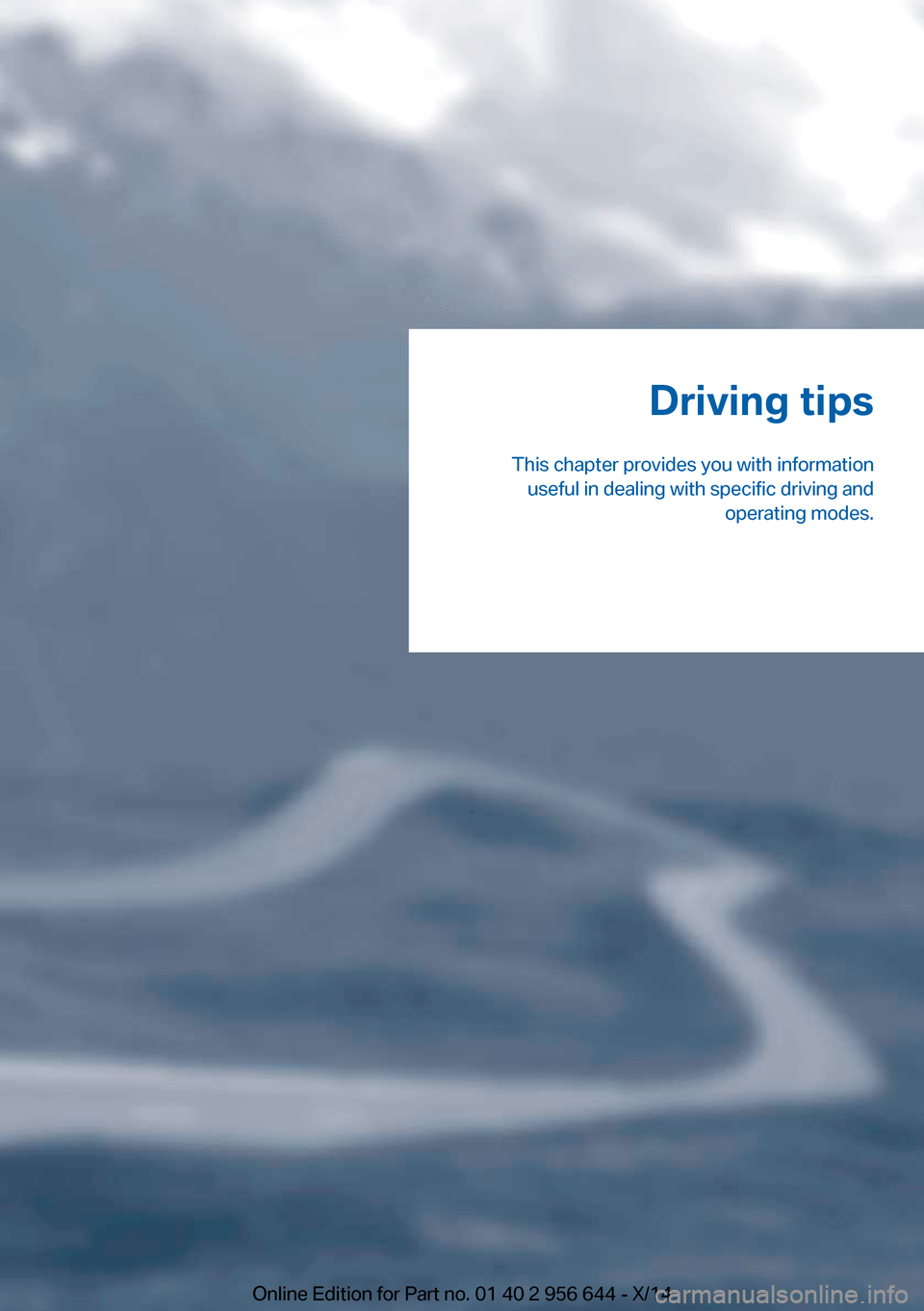
Driving tips
This chapter provides you with information useful in dealing with specific driving and operating modes.Online Edition for Part no. 01 40 2 956 644 - X/14
Page 176 of 251
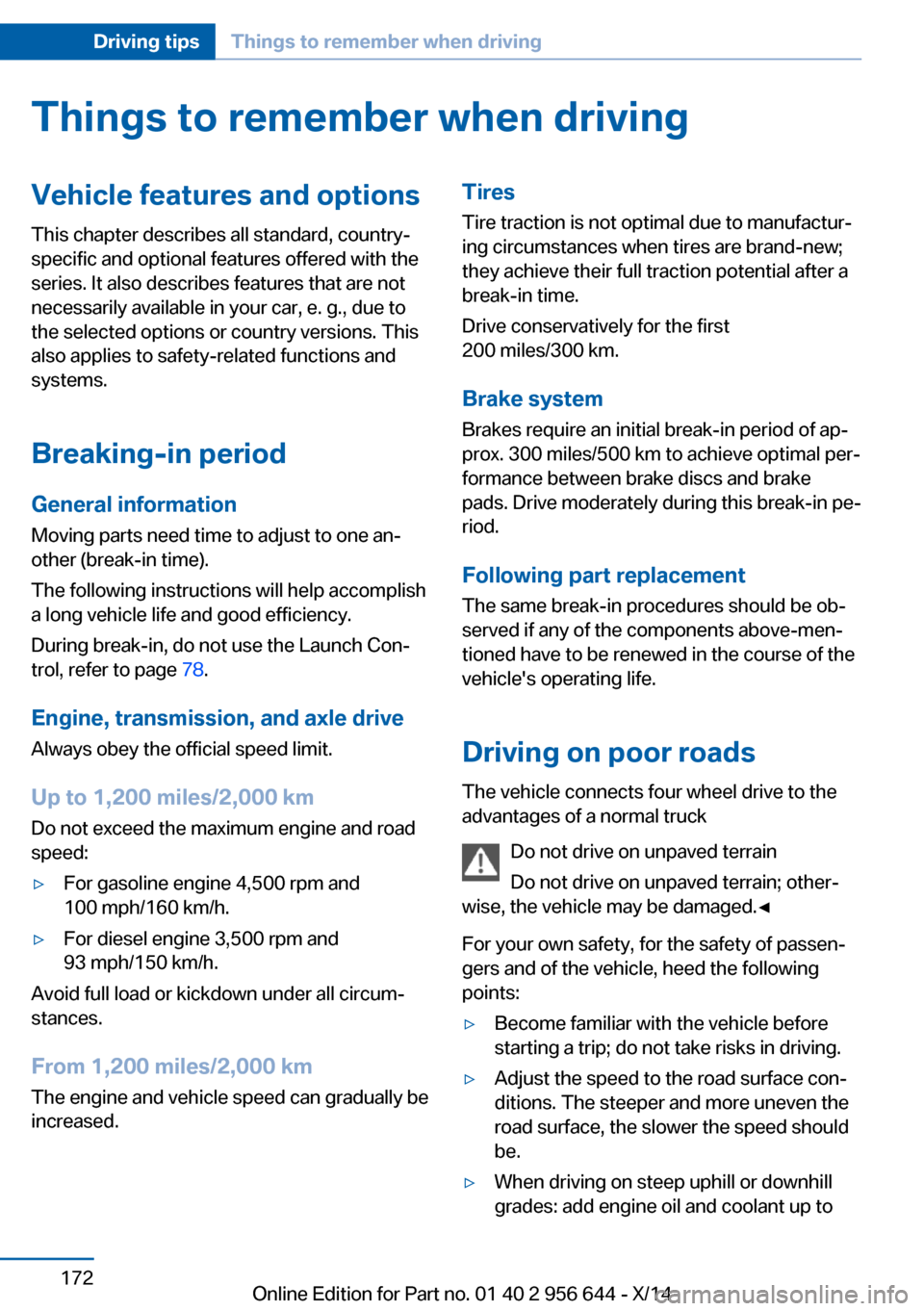
Things to remember when drivingVehicle features and options
This chapter describes all standard, country-
specific and optional features offered with the
series. It also describes features that are not
necessarily available in your car, e. g., due to
the selected options or country versions. This
also applies to safety-related functions and
systems.
Breaking-in period
General information Moving parts need time to adjust to one anâ
other (break-in time).
The following instructions will help accomplish
a long vehicle life and good efficiency.
During break-in, do not use the Launch Conâ
trol, refer to page 78.
Engine, transmission, and axle drive Always obey the official speed limit.
Up to 1,200 miles/2,000 km
Do not exceed the maximum engine and road
speed:âˇFor gasoline engine 4,500 rpm and
100 mph/160 km/h.âˇFor diesel engine 3,500 rpm and
93 mph/150 km/h.
Avoid full load or kickdown under all circumâ
stances.
From 1,200 miles/2,000 km The engine and vehicle speed can gradually be
increased.
Tires
Tire traction is not optimal due to manufacturâ
ing circumstances when tires are brand-new;
they achieve their full traction potential after a
break-in time.
Drive conservatively for the first
200 miles/300 km.
Brake system
Brakes require an initial break-in period of apâ
prox. 300 miles/500 km to achieve optimal perâ
formance between brake discs and brake
pads. Drive moderately during this break-in peâ
riod.
Following part replacement The same break-in procedures should be obâ
served if any of the components above-menâ
tioned have to be renewed in the course of the
vehicle's operating life.
Driving on poor roads
The vehicle connects four wheel drive to the
advantages of a normal truck
Do not drive on unpaved terrain
Do not drive on unpaved terrain; otherâ
wise, the vehicle may be damaged.â
For your own safety, for the safety of passenâ
gers and of the vehicle, heed the following
points:âˇBecome familiar with the vehicle before
starting a trip; do not take risks in driving.âˇAdjust the speed to the road surface conâ
ditions. The steeper and more uneven the
road surface, the slower the speed should
be.âˇWhen driving on steep uphill or downhill
grades: add engine oil and coolant up toSeite 172Driving tipsThings to remember when driving172
Online Edition for Part no. 01 40 2 956 644 - X/14
Page 177 of 251
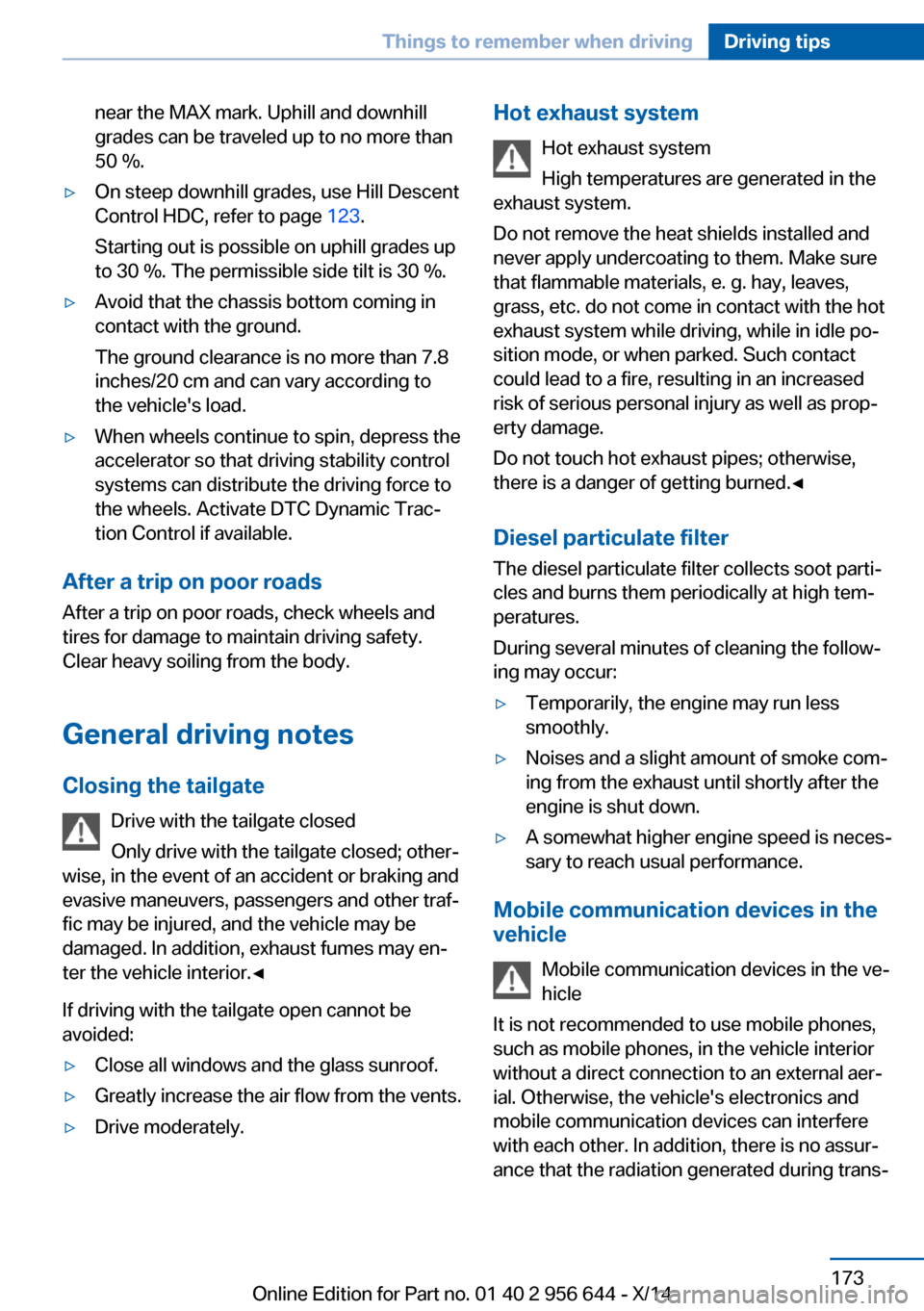
near the MAX mark. Uphill and downhill
grades can be traveled up to no more than
50 %.âˇOn steep downhill grades, use Hill Descent
Control HDC, refer to page 123.
Starting out is possible on uphill grades up
to 30 %. The permissible side tilt is 30 %.âˇAvoid that the chassis bottom coming in
contact with the ground.
The ground clearance is no more than 7.8
inches/20 cm and can vary according to
the vehicle's load.âˇWhen wheels continue to spin, depress the
accelerator so that driving stability control
systems can distribute the driving force to
the wheels. Activate DTC Dynamic Tracâ
tion Control if available.
After a trip on poor roads
After a trip on poor roads, check wheels and
tires for damage to maintain driving safety.
Clear heavy soiling from the body.
General driving notes
Closing the tailgate Drive with the tailgate closed
Only drive with the tailgate closed; otherâ
wise, in the event of an accident or braking and
evasive maneuvers, passengers and other trafâ
fic may be injured, and the vehicle may be
damaged. In addition, exhaust fumes may enâ
ter the vehicle interior.â
If driving with the tailgate open cannot be
avoided:
âˇClose all windows and the glass sunroof.âˇGreatly increase the air flow from the vents.âˇDrive moderately.Hot exhaust system
Hot exhaust system
High temperatures are generated in the
exhaust system.
Do not remove the heat shields installed and
never apply undercoating to them. Make sure
that flammable materials, e. g. hay, leaves,
grass, etc. do not come in contact with the hot
exhaust system while driving, while in idle poâ
sition mode, or when parked. Such contact
could lead to a fire, resulting in an increased
risk of serious personal injury as well as propâ
erty damage.
Do not touch hot exhaust pipes; otherwise,
there is a danger of getting burned.â
Diesel particulate filter The diesel particulate filter collects soot partiâ
cles and burns them periodically at high temâ
peratures.
During several minutes of cleaning the followâ
ing may occur:âˇTemporarily, the engine may run less
smoothly.âˇNoises and a slight amount of smoke comâ
ing from the exhaust until shortly after the
engine is shut down.âˇA somewhat higher engine speed is necesâ
sary to reach usual performance.
Mobile communication devices in the
vehicle
Mobile communication devices in the veâ
hicle
It is not recommended to use mobile phones,
such as mobile phones, in the vehicle interior
without a direct connection to an external aerâ
ial. Otherwise, the vehicle's electronics and
mobile communication devices can interfere
with each other. In addition, there is no assurâ
ance that the radiation generated during transâ
Seite 173Things to remember when drivingDriving tips173
Online Edition for Part no. 01 40 2 956 644 - X/14
Page 178 of 251
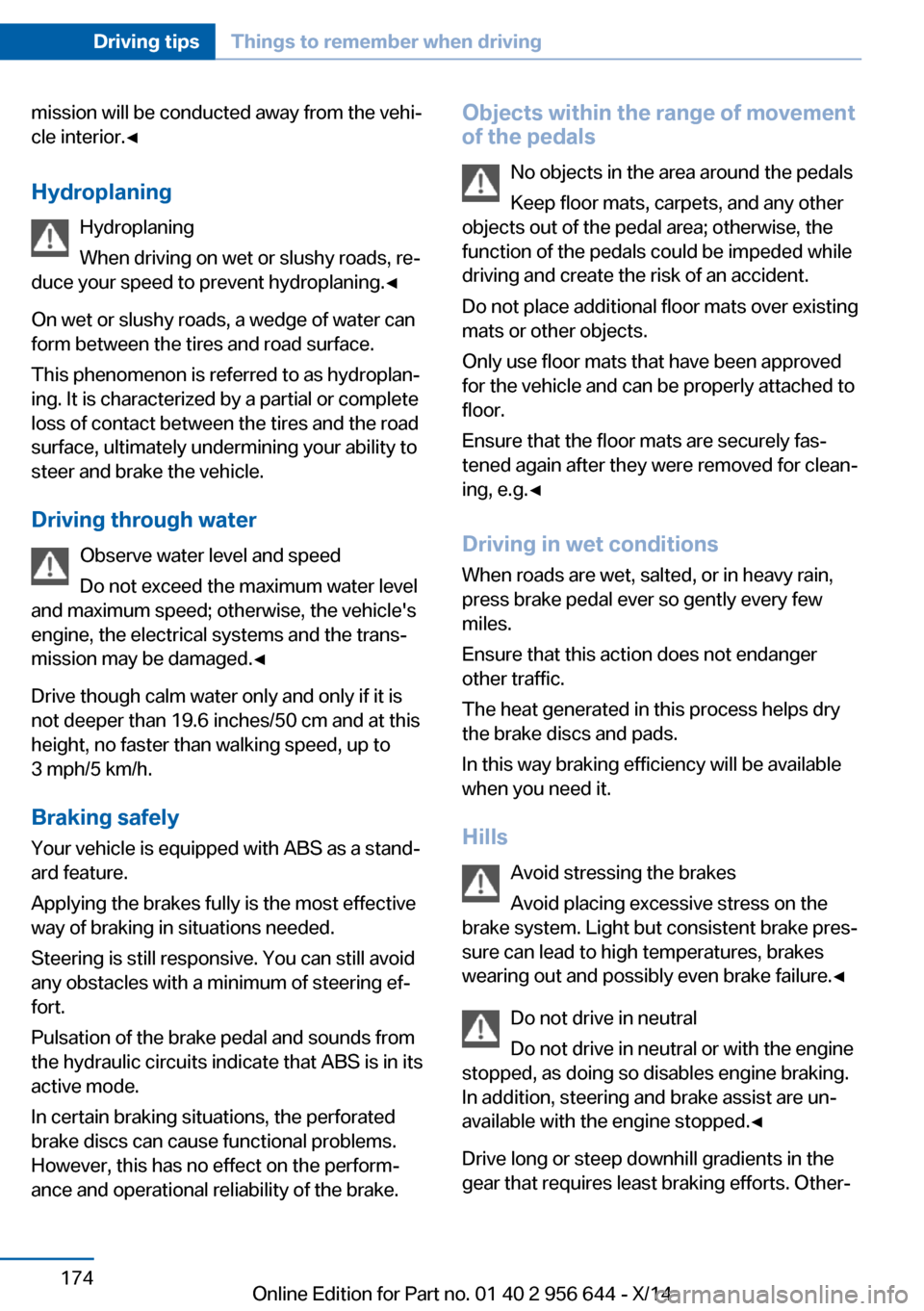
mission will be conducted away from the vehiâ
cle interior.â
Hydroplaning Hydroplaning
When driving on wet or slushy roads, reâ
duce your speed to prevent hydroplaning.â
On wet or slushy roads, a wedge of water can
form between the tires and road surface.
This phenomenon is referred to as hydroplanâ
ing. It is characterized by a partial or complete
loss of contact between the tires and the road
surface, ultimately undermining your ability to
steer and brake the vehicle.
Driving through water Observe water level and speed
Do not exceed the maximum water level
and maximum speed; otherwise, the vehicle's
engine, the electrical systems and the transâ
mission may be damaged.â
Drive though calm water only and only if it is
not deeper than 19.6 inches/50 cm and at this
height, no faster than walking speed, up to
3 mph/5 km/h.
Braking safely
Your vehicle is equipped with ABS as a standâ
ard feature.
Applying the brakes fully is the most effective
way of braking in situations needed.
Steering is still responsive. You can still avoid
any obstacles with a minimum of steering efâ
fort.
Pulsation of the brake pedal and sounds from
the hydraulic circuits indicate that ABS is in its
active mode.
In certain braking situations, the perforated
brake discs can cause functional problems.
However, this has no effect on the performâ
ance and operational reliability of the brake.Objects within the range of movement
of the pedals
No objects in the area around the pedals
Keep floor mats, carpets, and any other
objects out of the pedal area; otherwise, the
function of the pedals could be impeded while
driving and create the risk of an accident.
Do not place additional floor mats over existing
mats or other objects.
Only use floor mats that have been approved
for the vehicle and can be properly attached to
floor.
Ensure that the floor mats are securely fasâ
tened again after they were removed for cleanâ
ing, e.g.â
Driving in wet conditions When roads are wet, salted, or in heavy rain,
press brake pedal ever so gently every few
miles.
Ensure that this action does not endanger other traffic.
The heat generated in this process helps dry
the brake discs and pads.
In this way braking efficiency will be available
when you need it.
Hills Avoid stressing the brakes
Avoid placing excessive stress on the
brake system. Light but consistent brake presâ
sure can lead to high temperatures, brakes
wearing out and possibly even brake failure.â
Do not drive in neutral
Do not drive in neutral or with the engine
stopped, as doing so disables engine braking.
In addition, steering and brake assist are unâ
available with the engine stopped.â
Drive long or steep downhill gradients in the
gear that requires least braking efforts. OtherâSeite 174Driving tipsThings to remember when driving174
Online Edition for Part no. 01 40 2 956 644 - X/14
Page 179 of 251
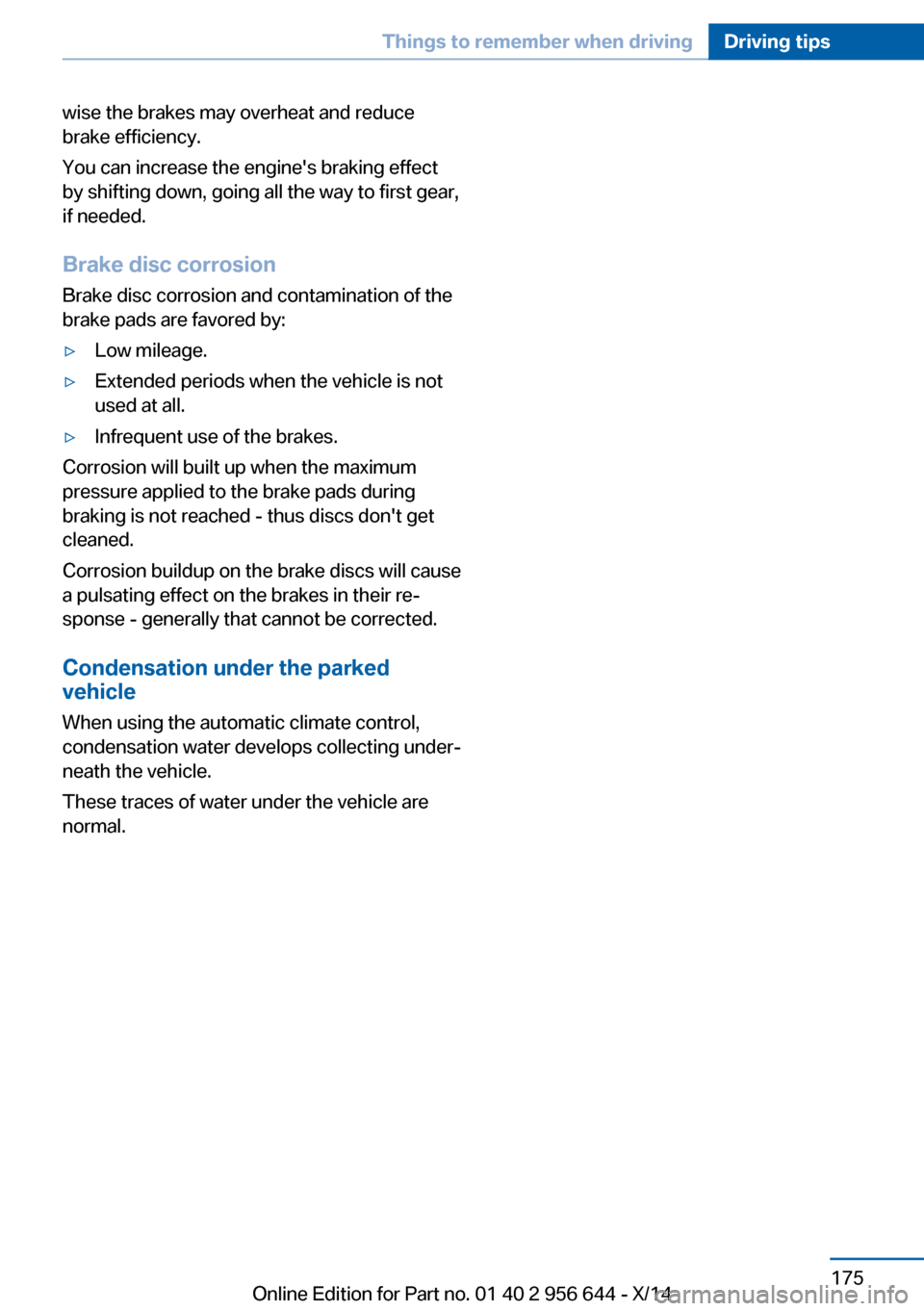
wise the brakes may overheat and reduce
brake efficiency.
You can increase the engine's braking effect
by shifting down, going all the way to first gear,
if needed.
Brake disc corrosion
Brake disc corrosion and contamination of the
brake pads are favored by:âˇLow mileage.âˇExtended periods when the vehicle is not
used at all.âˇInfrequent use of the brakes.
Corrosion will built up when the maximum
pressure applied to the brake pads during
braking is not reached - thus discs don't get
cleaned.
Corrosion buildup on the brake discs will cause
a pulsating effect on the brakes in their reâ
sponse - generally that cannot be corrected.
Condensation under the parked
vehicle
When using the automatic climate control,
condensation water develops collecting underâ
neath the vehicle.
These traces of water under the vehicle are
normal.
Seite 175Things to remember when drivingDriving tips175
Online Edition for Part no. 01 40 2 956 644 - X/14
Page 180 of 251
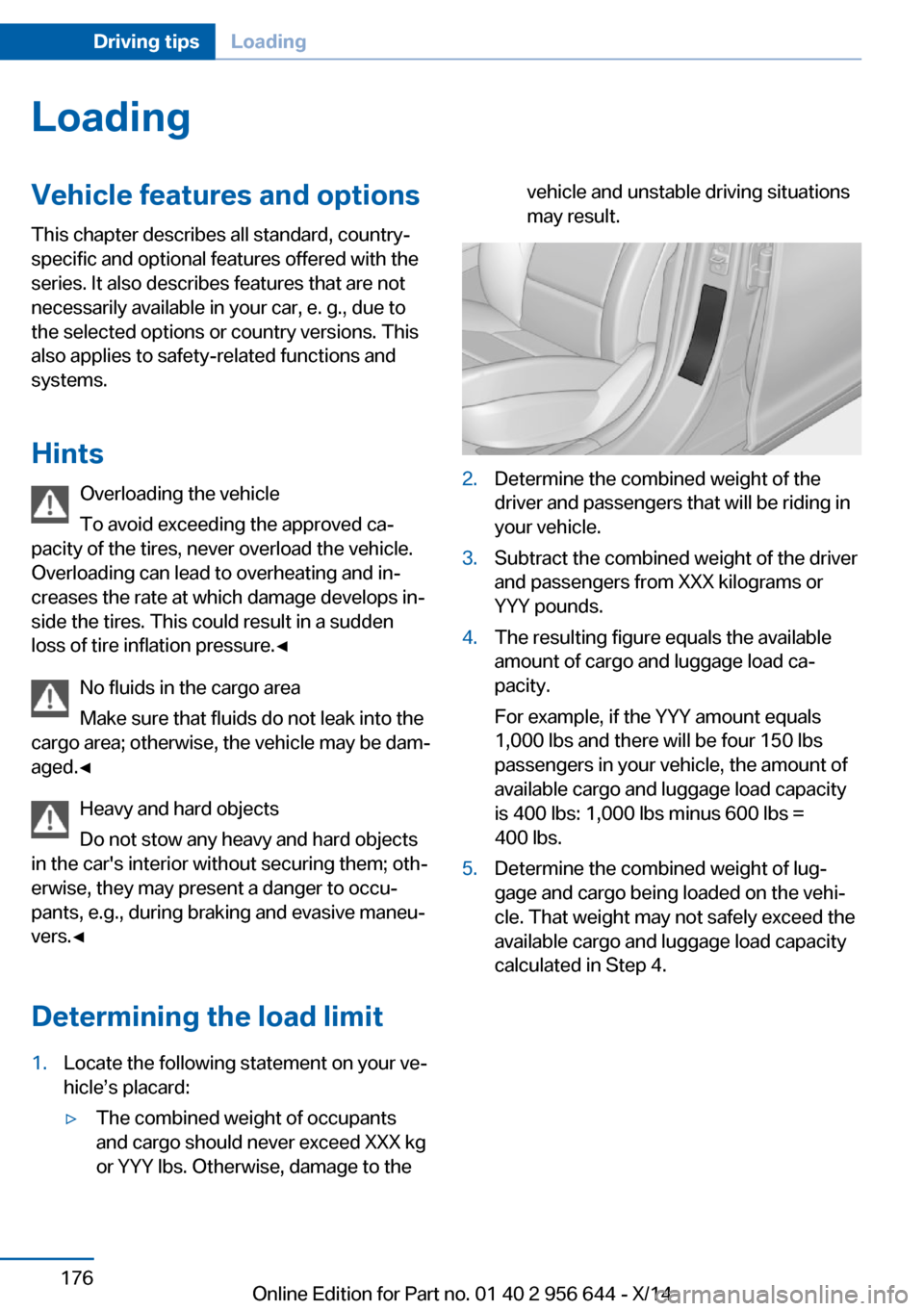
LoadingVehicle features and options
This chapter describes all standard, country-
specific and optional features offered with the
series. It also describes features that are not
necessarily available in your car, e. g., due to
the selected options or country versions. This
also applies to safety-related functions and
systems.
Hints Overloading the vehicle
To avoid exceeding the approved caâ
pacity of the tires, never overload the vehicle.
Overloading can lead to overheating and inâ
creases the rate at which damage develops inâ
side the tires. This could result in a sudden
loss of tire inflation pressure.â
No fluids in the cargo area
Make sure that fluids do not leak into the
cargo area; otherwise, the vehicle may be damâ
aged.â
Heavy and hard objects
Do not stow any heavy and hard objects
in the car's interior without securing them; othâ
erwise, they may present a danger to occuâ
pants, e.g., during braking and evasive maneuâ
vers.â
Determining the load limit1.Locate the following statement on your veâ
hicleâs placard:âˇThe combined weight of occupants
and cargo should never exceed XXX kg
or YYY lbs. Otherwise, damage to thevehicle and unstable driving situations
may result.2.Determine the combined weight of the
driver and passengers that will be riding in
your vehicle.3.Subtract the combined weight of the driver
and passengers from XXX kilograms or
YYY pounds.4.The resulting figure equals the available
amount of cargo and luggage load caâ
pacity.
For example, if the YYY amount equals
1,000 lbs and there will be four 150 lbs
passengers in your vehicle, the amount of
available cargo and luggage load capacity
is 400 lbs: 1,000 lbs minus 600 lbs =
400 lbs.5.Determine the combined weight of lugâ
gage and cargo being loaded on the vehiâ
cle. That weight may not safely exceed the
available cargo and luggage load capacity
calculated in Step 4.Seite 176Driving tipsLoading176
Online Edition for Part no. 01 40 2 956 644 - X/14